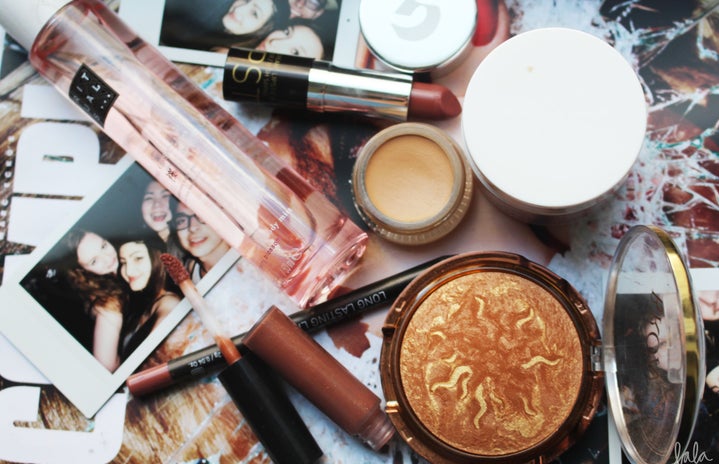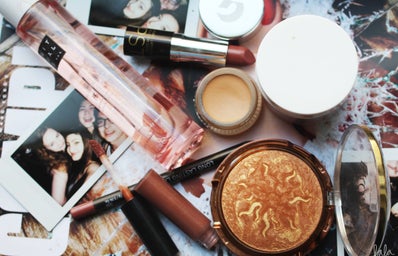Have you ever wondered how all the Tik Tok influencers get their makeup to look impossibly smooth? Why do the #sponsored products always work great on your favorite YouTuber’s channel but seem to be lacking when you try them out? As a former Tik Tok influencer myself, I’m here to tell you all the secrets to getting that perfect on-camera makeup look, how to find products that really work, and my personal go-to makeup routine!
First, let me introduce myself! My name is Logan and my Tik Tok handle is @loconuttt. You may or may not remember the girl that totally failed at reviewing the Aztec Secret clay face mask and then had an allergic reaction to it… that was me. I started making videos during quarantine, sharing my funny stories from doing friends’ and family’s makeup for events and photoshoots (believe it or not, crazy stuff goes down while doing people’s makeup sometimes). Shortly thereafter, my account grew to over 120K followers! I started getting brand deals and receiving money from the Creator Fund. In my time as a creator, I learned that there are a lot of industry secrets most inflencers try to keep under wraps. Get out your notebooks, and let’s dive in!
*Disclaimer: I am not a certified professional, and all of the advice in this article is from my own personal experiences.
it’s not all lights and Filters
The haters will say it’s all filters… the truth is, that’s part of the equation, but influencers still put in some work to look good for their fans. Bright lights wash out a lot of the color and texture that gets picked up in natural lighting, which is why having a good lighting setup is so important for high-quality pictures and videos. The lights offer a smoothing effect even before the editing stage. Filter preferences vary, but personally, I never preferred using lots of filters if I could get my makeup to look on point beforehand.
In order to counter act the lights, you have to overcompensate with extra product. Specifically, the bronzer, coutnour, and blush. When you put a bright light on your face, naturally, some will reflect. What’s reflected is the light itself, not the tone that you placed on that part of your face. This is what I mean by lights “wash out the colors” on your skin. Adding a bit of extra blush or bronzer will allow the camera to still pick up on those products in your pictures and videos.
Camera quality also plays a HUGE part in how your final look turns out. Even though high-definition cameras can give your post that extra flare, they can pick up on some pretty fine textures on your skin. Enlarged pores, peach fuzz, and creases won’t be able to escape the camera’s 20-20 vision. Again, the solution is adding a little extra product. In order to help smooth lines and bumps, you should try out a blur primer under a lightweight but full-coverage foundation. At the end of the article, I’ll share with you my favorite foundation to combat high-def equipment.
I want to emphasize that these tips work for any camera ready makeup! Professional headshots, Instagram selfies, or Tik Toks! If you’re using lights and high quality equipment, you’re going to want to add a little extra. If you want a more natural look, go easy on powder and mattifying products, and avoid unnatural shades like blacks, greys and neons. However, “no-makeup-makeup” is still more than you probably think.
The illusion of lights when it comes to makeup is pretty well illustrated in this Twitter thread. In the original post by KenBarbie, you see two photos of vocalist, Ashanti, from 20 years apart. Joyce Phillips jumps in to correct @youdointoomuch who assumed the image was merely showing a change in the makeup trends from 2002 to 2022. I agree with Joyce wholeheartedly! Sure, makeup trends have changed, they change every week, but what you’re really seeing in the image on the right is an upgrade in camera quality and a whole lot MORE makeup than what Ashanti is wearing in the original photo.
#sponsored: you see what they want you to see
Don’t be fooled into thinking that the products influencers promote are the magical ingredient to looking perfect on film. In fact, most of the time, it’s money talking, not them. I speak from experience when I say that some brands put tremendous pressure on social media personalities to sell their product, even if that means lying to their loyal followers for some extra cash.
Due to the fact that more and more people online are becoming aware of corrupt ads and doctored reviews, influencers and brands have been finding ways to sneak sponsored products into a seemingly normal post. Some brands will even ask specifically for influencers to “make the ad fit into their regular content” so that followers don’t quickly scroll past thinking its just another promotional post.
A good example of a viral product gone wrong is Jaclyn Hill’s first release with her beauty brand, Jacyln Cosmetics. The brand launched in mid 2019, following her Vault collection with Morphe Beauty. The release was hyped up by Jaclyn and a tribe of her ride or die creator friends. In all the reviews and posts leading up to the release, influencers, including Jaclyn, raved about the silky smooth lipstick collection and the overall quality of the product. Fast forward into the summer, fans sold out her first launch in a matter of hours. Jaclyn Cosmetic’s website even crashed due to an overload of orders being made simultaneously. When her customers received their product, they were alarmed to find fuzz stuck to the brand new lip products and un-paid reviews later showed that the lipstick itself was subpar in terms of wearability and texture. The point is, you shouldn’t always just take your favorite YouTuber’s word for it when they say that something is the best product they’ve ever tried.
The best way to find the real magic ingredients is to look for posts that are specifically not sponsored, or search for reviews posted by smaller creators and accounts. Although it’s a bit more of a hassle, heading to your local Ulta or Sephora is also a good bet. Both makeup retailers offer instore samples, and sometimes can even offer you a sample to take home and test out in your normal makeup routine (you might have to ask for them though). And they usually have real, certified makeup artists who can give you actual advice about what products might work best for you. The truth is, no influencer knows what is going to be right for YOUR skin. Almost no product is “great for all skin types”, because everyone’s skin is entirely unique. My advice on this issue: try it yourself before you buy!
my fave camera-ready routine
My personal go-to tiktok routine varies based on what kind of look I’m trying to achieve. However, a flawless base is always a must to get that famous camera-perfect skin. I would start off by making sure I moisturize at least 15 minutes before applying any other products. This gives your skin time to absorb the moisturizer, plump up a bit, and protect itself from absorbing the actual makeup.
Primer is optional in my opinion. If you want a dewy, glow-from-the-inside-out look, I would suggest applying some glow serum under your foundation or mixing it into your base before you apply. For a snatched, matte appearance, it’s definitely worthwhile to apply a mattifying primer. Going primer-less doesn’t necessarily mean your makeup won’t last as long or that it will slide off halfway through the day. In my experience, some primers do the opposite of what they’re supposed to if you accidentally pair it with a product that it doesn’t interact with it well. Typically, going no-primer will give you a more natural finish.
As a base, you’ll want to ensure your foundation does not include sunscreen to avoid any white cast or flashback in front of the camera. James Charles’ “Flash Back Marry” fiasco was a case of using a sunscreen-infused base in front of flash photographers. You can avoid this by simply checking the product’s ingredients before use. Most products with sun protection will display this right on the front of the packaging as well. (Please note: Sunscreen is a MUST for everyday wear- I always recommend using sun protection if you plan on being outside.) My all time favorite foundation for on-camera use is the Makeup Forever Ultra HD Foundation. It feels lightweight and buttery, but offers buildable coverage and can be mattified with a simple setting powder or glowed up with some good highlighter on top. Concealers can be applied before or after foundation, it’s really up to you! Sometimes I apply them first if I want a more natural look and, if I really want to make my undereye pop, I’ll go a shade lighter on top of the foundation instead. Even if you want a high-contrast Kim K contour, I wouldn’t suggest using shades that are more than 2 shades different from your foundation (for contour or highlighting).
After getting your flawless base done, the sky is the limit for the eye looks you can create. When I first started out, Pinterest was my go-to for fun makeup inspiration. For Tik Tok in particular, I wouldn’t shy away from bold colors and graphic trends, like the one below. If you want a more wearable, every-day look, stick to neutrals and light shimmers for your eyes and maybe throw on some faux freckles for an ultra-cute touch. For eyebrows, I’m still stuck on the Anastasia Dip Brow Pomade. With a sharp angled brush and a light hand, you can create a soft fluffy brow or a sharp Insta-brow all with one product.
I always finish by setting the makeup into place. My go-to powder is the Cody Airspun in Translucent. I apply powder all over because I am naturally pretty oily, especially when I get out into this Texas heat. If you have dry skin, you might want to skip applying a setting powder all over and stick to the t-zone (middle of the forehead, down the nose, and on the chin). Be careful with “baking”. Although it does give a nice brightness and provides some extra staying power for your concealers, applying too much can lead to creasing and cakiness as you wear it. I like to set my brows using a clear gel, rather than a tinted one that picks up on all my little peach fuzz. Finally, I give everything a quick spritz of setting spray which really helps to provide a layer of protection between the makeup and anything that might disturb it on the skin.
So then why do I call myself an “ex-influencer”?
I call myself an “ex-influencer” because I no longer produce content regularly or accept brand deals. It was a fun side gig for a while, and I am proud of the experiences and accomplishments I achieved through my platform. However, as school work got heavier and my future crept up, I realized that this wasn’t something I wanted to pursue long-term. Doing makeup will always be one of my interests and hobbies, but opening myself up to the world for criticism on my appearance is no longer something I am willing to do as I attempt to build a professional career.
I think one of the biggest things that impacts influencers is their audience and their followers. I would pull tips and suggestions from the comment section constantly. Part of getting better is learning from those around you. If you see something new and exciting, TRY IT! If you call *bs* on a makeup hack, TEST IT! That’s my best advice on how to find what works for you, your face shape, and your skin type. In the end, there are a lot of dark *secrets* to the influencer lifestyle, but there are also a lot of really great and genuine personalities out there on the internet, and it’s up to the viewers to decide who to support and what energy to give back to their favorite creators.


